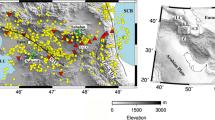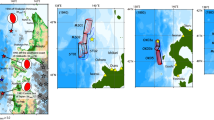Summary
Based on 90 accurately localized earthquakes in and around North-East India and the local crustal velocity model of Gupta et al. [4], the travel times of P-waves have been determined from the foci of these earthquakes at arbitrarily selected depths of 5, 13, 25, 41 and 50 km to the sites of the seismic stations operated by the Regional Research Laboratory, Jorhat and the National Geophysical Research Institute, Hyderabad, and also to the sites of the Shillong and Tura seismic stations run by the India Meteorological Department, New Delhi. The travel times of P-waves fit a straight line very well with velocities of 5·97 ± 0·31, 6·18 ± 0·01, 6·41 ± 0·03, 7·82 ± 0·07 and 7·95 ± 0·01 km/sec at each of the depths under study. Similar investigations of P* and Pg-waves of 16 earthquakes at a depth of 10 km have revealed velocities of 6·53 ± 0·31 and 5·64 ± 0·34 km/sec, respectively. A simplified two-layered crustal model consisting of an average crustal thickness of 41·5 km with 22·2 and 19·3 km thick layers has been obtained.
Similar content being viewed by others
References
K. E. Bullen: An introduction to the Theory of Seismology, Cambriege Univ. Press, Cambridge, 3rd ed., (1963), 381 pp.
P. Evans: The tectonic framework of Assam. J. Geol. Soc. India, 5 (1964), 80.
P. Evans, W. Crompton: Geological factors in gravity interpretation by evidence from India and Burma.Quart. J. Geol. Soc., London, 102 (1946), 211.
H. K. Gupta, S. C. Singh, T. K. Dutta, M. M. Saikia: Recent investigations of North-East India seismicity. Internat. Symp. Continental Seismology and Earthquake Prediction, Beijing (1982), 63.
H. Jeffreys, K. E. Bullen: Seismological Tables. British Ass. for the Advancement of Science, Gray-Milne Trust, London (1958).
W. H. K. Lee, J. C. Lahr: HYPO-71 — A computer programme for determining hypocentre, magnitude and first motion pattern of local earthquakes. U.S. Geol. Surv. Open File Rept. (1974), 100 pp.
L. P. Mathur, P. Evans: Oil in India. 22nd Internat. Geol. Congr. New Delhi (1964), 142 pp.
C. F. Richter: Elementary Seismology. W. H. Freeman and Co., San Francisco (1958), 768 pp.
S. C. Roy: Seismometric study. Mem. Geol. Surv. India, 73 (1939), 49.
S. N. Saha, V. K. Gaur, V. Bansal, M. Wyss, K. Khattri: Microearthquakes in North-East India. Symp. Earthq. Disaster Mitigation, Univ., Roorkee, March 4–6, 2 (1981), 65.
A. N. Tandon: Study of great Assam earthquake of August 1950 and its aftershocks. Indian J. Meteor. Geoph., 5 (1954), 95.
H. H. Turner: Revised Seismological Tables and the Earth's liquid core. MNRAS, Geoph. Suppl., 1 (1926), 425.
R. K. Verma, R. P. Gupta: Relationship of gravity anomalies and tectonics in Assam, India. Tectonophysics, 18 (1973), 19.
Author information
Authors and Affiliations
Rights and permissions
About this article
Cite this article
Sitaram, M.V.D., John, G., Rao, P.G. et al. Travel times ofP-waves in North-East India. Stud Geophys Geod 34, 96–109 (1990). https://doi.org/10.1007/BF02295830
Received:
Published:
Issue Date:
DOI: https://doi.org/10.1007/BF02295830




